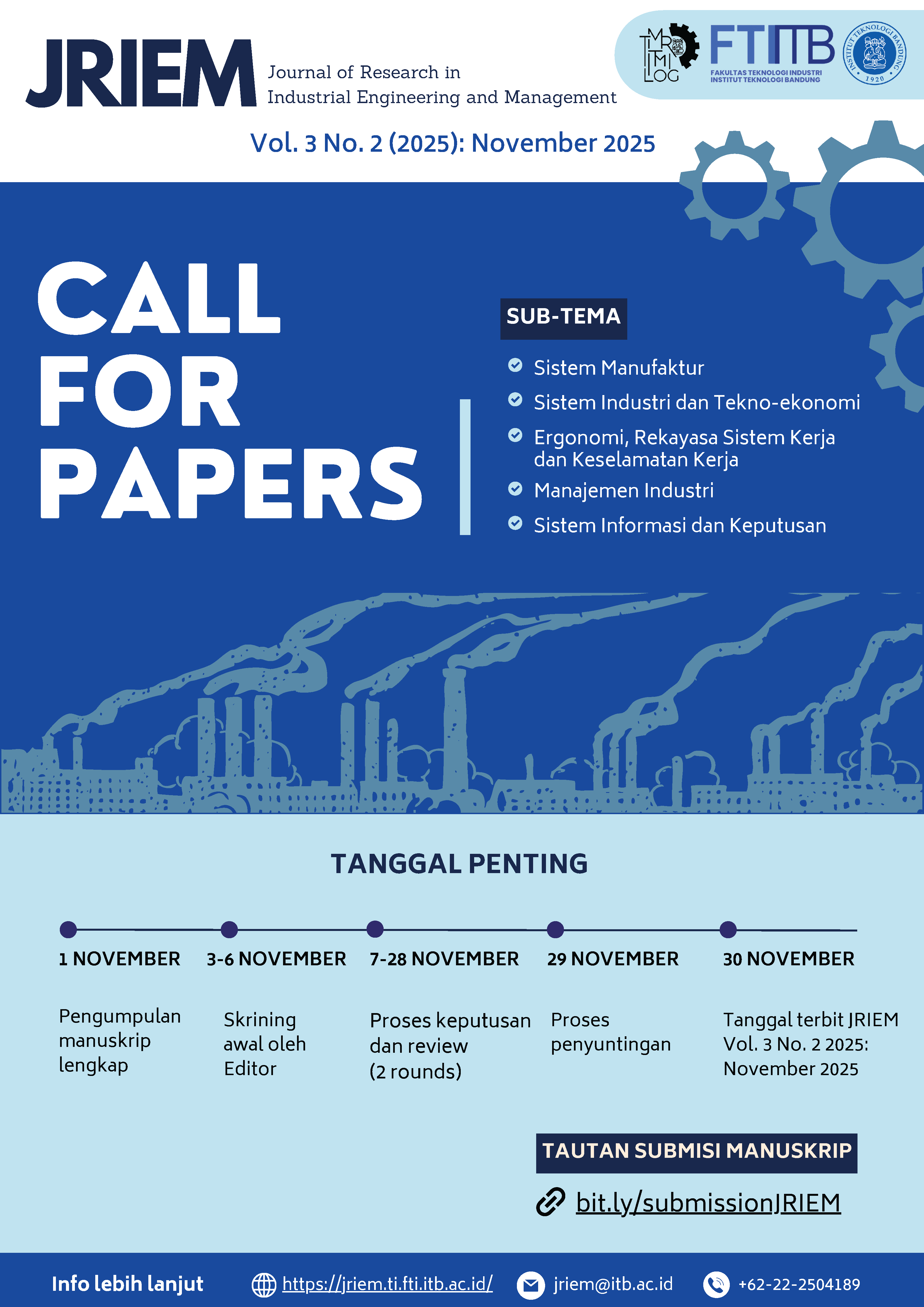Penerapan Studi Green Marketing pada Pengukuran Niat Memilah Sampah Berdasarkan Perbedaan Generasi dalam Mengatasi Permasalahan Sampah di Bandung Raya
DOI:
https://doi.org/10.61221/jriem.v3i1.43Kata Kunci:
pemilahan sampah, nostalgia, nilai epistemik, nilai emosional, keterikatan tempat, sikapAbstrak
Permasalahan sampah di Kota Bandung, termasuk proses pemilahan sampah yang belum efektif, terutama di tingkat rumah tangga, merupakan masalah yang cukup signifikan. Perlu adanya kesadaran masyarakat, terutama dalam memilah sampah menjadi sampah organik, anorganik, dan residu. Kesadaran masyarakat dalam mengelola sampah membutuhkan keyakinan, prinsip, dan pertimbangan etika terhadap lingkungan berdasarkan nilai-nilai yang dianut masing-masing individu. Nostalgia dapat menjadi media atau stimulus untuk menumbuhkan niat untuk terlibat dalam kegiatan pemilahan sampah atau praktik-praktik yang ramah lingkungan. Penelitian ini meneliti pengaruh perbedaan generasi. Nostalgia memiliki pengaruh yang berbeda untuk setiap generasi dan menjadi lebih kuat seiring bertambahnya usia. Setiap generasi juga memiliki pengaruh untuk nilai, keterikatan tempat, dan attitude yang dimiliki oleh setiap individu. Penelitian ini melibatkan 236 responden dari wilayah Bandung Raya yang dibedakan menjadi tiga kelompok generasi yaitu Generasi X-Baby Boomers, Generasi Y, dan Generasi Z. Hasil penelitian menunjukkan bahwa terdapat perbedaan nostalgia, nilai epistemik, nilai emosional, keterikatan tempat, dan sikap terhadap perilaku pemilahan sampah berdasarkan kelompok generasi. Hasil ini berbeda untuk niat dalam memilah sampah yang tidak memiliki perbedaan untuk setiap generasi. Pemerintah, khususnya Dinas Lingkungan Hidup Kota Bandung (DLHK), dan organisasi profit dan non-profit dapat mengembangkan kampanye dan program yang memanfaatkan nostalgia sesuai generasi.
Referensi
1. Ajzen, I. (1991), “The theory of planned behavior”, Organizational Behavior and Human Decision Processes, Vol. 50 No. 2, pp. 179-211.
2. Awuni, J. A., & Du, J. (2016). Sustainable consumption in Chinese cities: green purchasing intentions of young adults based on the theory of consumption values. Sustainable Development, 24(2), 124-135.
3. Bei, L. T., & Simpson, E. M. (1995). The Determinants of Consumers' Purchase Decisions for Recycled Products: An Application of Acquisition-Transaction Utility Theory. Advances in consumer research, 22(1).
4. Benito-Ostolaza, J. M., Echavarri, R., Garcia-Prado, A., & Oses-Eraso, N. (2021). Using visual stimuli to promote healthy snack choices among children. Social Science and Medicine, 270. https://doi.org/10.1016/j.socscimed.2020.113587
5. Chen, Z., Ryan, C., & Zhang, Y. (2022). Cross-generational analysis of residential place attachment to a Chinese rural destination. Journal of Sustainable Tourism, 30(4), 787–806. https://doi.org/10.1080/09669582.2021.1890095
6. Cheung, W. Y., Sedikides, C., & Wildschut, T. (2017). Nostalgia proneness and reduced prejudice. Personality and Individual Differences, 109, 89–97. https://doi.org/10.1016/j.paid.2016.12.045
7. Cho, H. (2021). How nostalgia forges place attachment and revisit intention: a moderated mediation model. Marketing Intelligence and Planning, 39(6), 856–870. https://doi.org/10.1108/MIP-01-2021-0012
8. D’Amato, A., & Herzfeldt, R. (2008). Learning orientation, organizational commitment, and talent retention across generations. Journal of Managerial Psychology, 23, 929–953.
9. De Feo, G., Ferrara, C., Iannone, V., & Parente, P. (2019). Improving the efficacy of municipal solid waste collection with a communicative approach based on easily understandable indicators. Science of the Total Environment, 651, 2380–2390. https://doi.org/10.1016/j.scitotenv.2018.10.161
10. Domegan, C. T. (2008). Social marketing: Implications for contemporary marketing practices classification scheme. Journal of Business and Industrial Marketing, 23(2), 135–141. https://doi.org/10.1108/08858620810850254
11. Gifford, R., & Nilsson, A. (2014). Personal and social factors that influence pro-environmental concern and behaviour: A review. Dalam International Journal of Psychology (Vol. 49, Nomor 3, hlm. 141–157). Wiley-Blackwell Publishing Ltd. https://doi.org/10.1002/ijop.12034
12. Gu, Q., Li, M., & Kim, S. (Sam). (2021). The role of nostalgia-evoking stimuli at nostalgia-themed restaurants in explaining benefits, consumption value and post-purchase behavioral intention. International Journal of Hospitality Management, 96. https://doi.org/10.1016/j.ijhm.2021.102955
13. Hair, J. F., Black, W. C., Babin, B. J., & Anderson, R. E. (2019). Multivariate Data Analysis Eighth Edition. www.cengage.com/highered
14. Hair, J. F., Hult, G. T. M., Ringle, C. M., & Sarstedt, M. (2022). A Primer on Partial Least Squares Structural Equation Modeling (PLS-SEM) 3rd ed. Sage Publications, California.
15. Jagau, H. L., & Vyrastekova, J. (2017). Behavioral approach to food waste: an experiment. British Food Journal, 119(4), 882–894. https://doi.org/10.1108/BFJ-05-2016-0213
16. Jiang, Y., & Hong, F. (2023). Examining the relationship between customer-perceived value of night-time tourism and destination attachment among Generation Z tourists in China. Tourism Recreation Research, 48(2), 220-233.
17. Joglekar, J., & Tan, C. S. L. (2022). The impact of LinkedIn posts on employer brand perception and the mediating effects of employer attractiveness and corporate reputation. Journal of Advances in Management Research, 19(4), 624–650. https://doi.org/10.1108/JAMR-10-2021-0343
18. Juhl, J., & Biskas, M. (2023). Nostalgia: An impactful social emotion. Dalam Current Opinion in Psychology (Vol. 49). Elsevier B.V. https://doi.org/10.1016/j.copsyc.2022.101545
19. Kementerian Lingkungan Hidup (2023). KLHK Sosialisasikan Pengelolaan Sampah Mulai Dari Sumbernya, diperoleh Juni 2023, melalui situs internet: https://ppid.menlhk.go.id/siaran_pers/browse/1150
20. Lacoste-Badie, S., Gagnan, A. B., & Droulers, O. (2020). Front of pack symmetry influences visual attention. Journal of Retailing and Consumer Services, 54. https://doi.org/10.1016/j.jretconser.2019.102000
21. Levinson, D. J. (1980). Toward a conception of the adult life course. In N. J. Smelser & E. H. Erikson (Eds.), Themes of work and love in adulthood (pp. 265–289). Cambridge, MA: Harvard University Press.
22. Liu, Q., Xu, Q., Shen, X., Chen, B., & Esfahani, S. S. (2022). The Mechanism of Household Waste Sorting Behaviour—A Study of Jiaxing, China. International Journal of Environmental Research and Public Health, 19(4). https://doi.org/10.3390/ijerph19042447
23. Madoglou, A., Gkinopoulos, T., Xanthopoulos, P., & Kalamaras, D. (2017). Representations of autobiographical nostalgic memories: Generational effect, gender, nostalgia proneness and communication of nostalgic experiences. Journal of Integrated Social Sciences, 7(1), 60-88.
24. Maffei, S. T., Simacek, P. E. D. R. O., Menezes, M. D. S., & Durão, M. J. (2014). Emotional design of fashion: development and application of new tool for non-interfering research. Second.
25. Marni, S., Aliman, M., Suyono, S., Roekhan, R., dan Harsiati, T. (2020). Students’ Critical Thinking Skills Based on Gender And Knowledge Group, Journal of Turkish Science Education, 17(4), 544–560. https://doi.org/10.36681/tused.2020.44
26. McKenzie-Mohr, S., Coates, J., & McLeod, H. (2012). Responding to the needs of youth who are homeless: Calling for politicized trauma-informed intervention. Children and Youth Services Review, 34(1), 136–143. https://doi.org/10.1016/j.childyouth.2011.09.008
27. Munirah Maharum, S., Md Isa, N., Salahuddin, N., & Saad, S. (2017). The Relationship between Dimension of Consumption Value and Intention to Purchase of Green Products. The International Journal of Business & Management, (Vol. 5).
28. Prokopenko dan Ossik (2015): Green Marketing, Karaganda: KSU Publishing House, Karaganda.
29. Rakhmawati, T., Damayanti, S., Jati, R. K., & Astrini, N. J. (2023). An extended TPB model of waste-sorting intention: a case study of Indonesia. Management of Environmental Quality: An International Journal, 34(5), 1248–1268. https://doi.org/10.1108/MEQ-11-2022-0309
30. Raymond, C. M., Brown, G., & Weber, D. (2010). The measurement of place attachment: Personal, community, and environmental connections. Journal of Environmental Psychology, 30(4), 422–434. https://doi.org/10.1016/j.jenvp.2010.08.002
31. Rotem, O. S., Weinstock, M., & Greenfield, P. M. (2024). Changes in values and ways of knowing among three generations of Israeli women of Ethiopian origin. Current Research in Ecological and Social Psychology, 6. https://doi.org/10.1016/j.cresp.2024.100186
32. Sedikides, C., & Wildschut, T. (2016). Past Forward: Nostalgia as a Motivational Force. Dalam Trends in Cognitive Sciences (Vol. 20, Nomor 5, hlm. 319–321). Elsevier Ltd. https://doi.org/10.1016/j.tics.2016.01.008
33. Şener, T., Bişkin, F., & Dündar, N. (2023). The effects of perceived value, environmental concern and attitude on recycled fashion consumption. Journal of Fashion Marketing and Management, 27(4), 595–611. https://doi.org/10.1108/JFMM-01-2021-0003
34. Sindonews (2023), Pemkot Bandung Klaim Sampah yang Dibuang ke TPA Sarimukti Turun Jadi 900 Ton. Data diperoleh melalui situs internet: https://daerah.sindonews.com/read/1274661/701/pemkot-bandung-klaim-sampah-yang-dibuang-ke-tpa-sarimukti-turun-jadi-900-ton-1702357938
35. Truong, V. D., Dong, X. D., Saunders, S. G., Pham, Q., Nguyen, H., & Tran, N. A. (2021). Measuring, evaluating, and documenting social marketing impact. Dalam Journal of Social Marketing (Vol. 11, Nomor 3, hlm. 259–277). Emerald Group Holdings Ltd. https://doi.org/10.1108/JSOCM-11-2020-0224
36. Trzesniewski, K. H., & Donnellan, M. B. (2010). Rethinking “Generation Me” a study of cohort effects from 1976–2006. Perspectives on Psychological Science, 5, 58–75.
37. Twenge, J. M., & Foster, J. D. (2010). Birth cohort increases in narcissistic personality traits among American college students 1982–2009. Social Psychological and Personality Science, 1, 99–106.
38. van Tilburg, W. A. P., Sedikides, C., & Wildschut, T. (2018). Adverse Weather Evokes Nostalgia. Personality and Social Psychology Bulletin, 44(7), 984–995. https://doi.org/10.1177/0146167218756030
39. Wan, C., Shen, G. Q., & Choi, S. (2021). The place-based approach to recycling intention: Integrating place attachment into the extended theory of planned behavior. Resources, Conservation and Recycling, 169. https://doi.org/10.1016/j.resconrec.2021.105549
40. Wang, J., & Hsu, Y. (2020). The relationship of symmetry, complexity, and shape in mobile interface aesthetics, from an emotional perspective-A case study of the smartwatch. Symmetry, 12(9). https://doi.org/10.3390/SYM12091403
41. Williams, D. R., Patterson, M. E., Roggenbuck, J. W., & Watson, A. E. (1992). Beyond the commodity metaphor: Examining emotional and symbolic attachment to place. Leisure Sciences, 14(1), 29–46. https://doi.org/10.1080/01490409209513155
42. Wu, S.-I., & Chang, H.-L. (2016b). The Model of Relationship between the Perceived Values and the Purchase Behaviors toward Innovative Products. Journal of Management and Strategy, 7(2). https://doi.org/10.5430/jms.v7n2p31
43. Zhang, X., Gong, X., & Jiang, J. (2021). Dump or recycle? Nostalgia and consumer recycling behavior. Journal of Business Research, 132, 594–603. https://doi.org/10.1016/j.jbusres.2020.11.033
Unduhan
Diterbitkan
Cara Mengutip
Terbitan
Bagian
Lisensi
Hak Cipta (c) 2025 Teddy Rahardian Yusuf, Hasrini Sari

Artikel ini berlisensi Creative Commons Attribution 4.0 International License.




